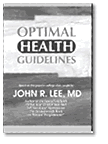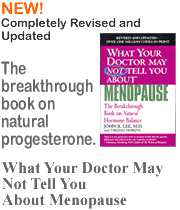|
|
||||
|
For suggestions on how to find a doctor in your area, please go to:
|
||||
Optimal Health Guidelines

Based on the popular college class taught by John R. Lee, M.D. BLL Publishing, 1999 (211 pages) Excerpted from Optimal Health Guidelines CHAPTER SIXTEEN: IATROGENIC DISEASE Going to the doctor these days can be risky business. In generations past, a basic tenet of medical care was Primum non nocere (above all, do no harm). Today, that dictum has been modified to do as little harm as possible . Even that, as we shall see, is becoming operationally impossible. The patient now must learn to look out for himself.Iatrogenic disease refers to health problems resulting from treatments by medical authorities. This is not a health problem of small consequence nor is it new. The history of medicine is replete with many examples, from therapeutic bleeding to laudable pus. What is most curious about them is the fact that the problems created (so obvious in retrospect) were, in their time, so long unrecognized. Perhaps this is still true. More importantly, a recent study found 25% of hospital admissions to be directly related to medical mismanagement of some kind or another. It is appropriate, therefore, that we take a good look at this problem. An excellent book to read on the subject of iatrogenic disease is Dr. E. D. Robinís Matters of Life & Death: Risks vs. Benefits of Medical Care. Almost all medications have undesirable side effects, which are often not fully realized by the patient or his/her doctor. The treatment of one condition may exacerbate another. This is not rare; in fact, it is generally the rule. Sometimes, an errant health notion is so widespread throughout the health community that literally millions of people suffer from it without suspecting the cause. (Dr. Robin then calls it an iatro-epidemic ) Various examples are now well known: the use of tetracycline antibiotics in childhood (caused discoloration of developing teeth); the Sippy diet for ulcers (milk causes acid rebound); the use of pHisohex baby powder (hexachlorophene is neurotoxic) ; excessive dietary protein advice of 30 years ago; the excessive cola drinks of today; and the casual use of radium and Xray just one generation ago. All of these induced iatrogenic disease in large numbers. The doctor doesnít set out, of course, to purposefully harm the patient. But somehow he/she canít seem to help it. Let us look at some of the reasons for the problem. 1. The phenomenal ongoing proliferation of medications and treatments available make it impossible for even the most responsible doctor to keep up with the ever expanding knowledge of possible contraindications and side effects, let alone the interactions between them when used in combinations. 2. Not all side effects are known when the drug is released for general use. Animal tests and limited clinical trials are simply incapable of providing a broad enough database for reactions that might be quite rare. 3. Surprising as it may seem to some, spin-doctoring is rampant in medical literature. Doctors who are not impartial in their advocacy of a drug or treatment about which they are reporting often write articles published in even the most prestigious medical journals. It is very easy to exaggerate presumed treatment benefit and minimize undesirable side effects. Medical research is financed primarily by drug companies hoping to make money selling a drug. They choose researchers who will, in effect, put the right spin on their results. Studies that are not favorable (to the pharmaceutical companyís interest) do not get published. Medical research careers often depend on satisfying the desires of the pharmaceutical interests that pay for the research. It is important to remember that pharmaceutical interests are not the same as patientsí interest. Drug companies know physicians in general do not have the time to critically review medical literature; they rely on summaries. Also, they know that few physicians are skilled in statistics or the necessity of good study design. A good example of deception in drug testing is the well-written book by Peter R. Breggin, MD, Toxic Psychiatry, concerning the promotion of drugs used in psychiatry. The lessons learned in that book apply also to all fields of medical research. 4. Individual differences among patients are unpredictable and more common than generally realized. Furthermore, many of the pre-approval appraisals were performed on healthy young adults whereas, in practice, the patient may be a malnourished 85 year-old with a bad liver. 5. The patient may have several doctors, each prescribing drugs without knowledge of or consultations concerning the polypharmacy risk being created. Or, the patient is also taking over-the-counter medications without the doctorís knowledge. The possible drug interactions become unmanageably complex. 6. The patient has been led to believe that the doctor always knows best. But the doctor is also human and, as such, prone to error. 7. The doctor has been trained in a mind-set derived from the war against bacterial infections in which success (such as it was) was achieved by a process of diagnosing diseases by their signs and symptoms in order to identify the infecting organism so the proper antibiotic may be employed to kill it. But, todayísí diseases are of a different sort as we have seen; the magic bullet theory doesnít apply. Todayís treatments must consider the broad matrix of interrelating factors that effect immune competence, nutritional adequacy, individual genetic and environmental differences, toxins, and viruses for which no antibiotics yet exist. He must learn to think in terms of intra-cellular metabolic functions rather than superficial manifestations; he must strive to augment natural defenses rather than merely treat symptoms; he must educate his patient in matters of nutrition and care of his body rather than wait for disease to become overt. You must understand that he is ill prepared by his training to do this. 8. The doctorís required continuing medical education (CME) is often at the hands of the pharmaceutical industry whose business it is to sell their products. Unless constantly mindful, he will succumb to the propaganda and believe himself educated. Not only has he now become part of the problem but the time taken by these pharmaceutical-provided medical seminars reduces the likelihood that he will ever, on his own, get around to learning about the solution such as, for instance, reading The Kellogg Report: The Impact of Nutrition, Environment & Lifestyle on the Health of Americans, a 735 page opus from the Institute of Health Policy and Practice. 9. There is the prevalent notion that health is a free ride requiring no effort on our part for it to be achieved. If it ainít broke, donít fix it. As long as you can make it through the day, youíre all right. This is nonsense, of course. We do know better but we donít like to think about it. We take care of our cars; why donít we learn how to take care of our bodies? Instead, we wait until something does break down and then expect the doctor to fix it with magic. This is the perfect setting for iatrogenic disease. 10. Iatrogenic medicine also involves governmental medical bureaucracies, such as the Food and Drug Agency, the National Institutes of Health, or the Public Health Service. The nature of bureaucracies is such that being a team member is more highly rewarded than being a dissident. Criticizing the policies of oneís superior does not usually strengthen oneís career. Thus, an established health policy, whether erroneous or not, tends strongly to become a fixed policy, almost immune to the normal changes and new under- standings that regularly occur in general medical practice. One such example is fluoridation which originated over 50 years ago with the observation that mottled dental enamel was caused by fluoride in drinking water and an apparent (but inadequately tested) correlation of water fluoride with fewer dental cavities in children. Despite protests from many physicians and toxicologists, the addition of fluoride compounds to public water became a fixed policy of the Department of Health & Human Services (HHS), previously known as the Public Health Service (PHS). Flawed early studies appeared to support this policy. More recent and far better studies have now shown that: (1) the decline in childrenís dental caries is less a function of water fluoridation than of better diet, better dental hygiene, or an acquired immune response to cariogenic plaque bacteria (Strep mutans); (2) the toxicity of fluoride is much greater than previously thought (correlated with increased cancer, particularly osteosarcoma [in young males]), colon cancer, heart arrhythmia deaths, gastritis, and osteoporotic hip fracture; and (3) the typical total daily intake of fluoride (due to fluoridated water-processing of food and to high fluoride toothpaste) now exceeds known toxic levels in US communities regardless of fluoridation status. Previously, optimal fluoridation (i.e., presumed to be safe) was defined as that intake that caused < 10% of the children to have mottled teeth. The PHS now admits that dental fluorosis is found in 10% of children in unfluoridated communities and in 34% of children in fluoridated communities. Rather than reducing water fluoride concentrations, the PHS calls for more money for research in decreasing fluoride exposure from other sources such as food-borne and toothpaste fluoride. In this regard, it should be recalled that, for reasons of toxicity and lack of efficacy, Japan, India and all western European countries (except Spain which is still battling over it) have decided against the practice; and Australia now advocates decreasing their fluoride concentration to one-half that of ours. Yet, despite all the evidence against it, our PHS continues to advocate the same fluoridation level as it did in 1943 when food-borne fluoride and fluoridated toothpaste did not exist. Thus, iatrogenic disease takes many forms. As patients, we must be ever vigilant and not be timid in challenging our health authorities to keep up with medical knowledge and to follow the rule of primum non nocere . Itís our health, after all. A FEW EXAMPLES OF IATROGENIC PROBLEMS 1. Between 4-10 % of all hospital admissions are due to adverse drug reactions. 2. Over 20 % of hospital admissions are due to mismanagement of drugs, either by the patient or the doctor. 3. One study suggests that over-prescription of hypertension drugs may cause 25,000 heart attacks each year. Estimated cost is over $1 billion. 4. Side effects of about 70 million prescriptions annually for non-steroidal anti-inflammatory drugs (NSAIDs) include 200-300,000 cases of gastro-intestinal tract bleeding each year, leading to 10-20,000 deaths. 5. Unopposed estrogen is the only known cause of endometrial cancer and probably increases the risk of breast cancer, yet it is widely prescribed to postmenopausal women for hot flashes and retarding osteoporosis. When accompanied by synthetic progestins (to decrease the endometrial cancer risk), these impose a different set of potential adverse side effects. 6. Broad-spectrum antibiotic use predisposes one to secondary yeast infections, loss of friendly colon flora (e.g., the ones producing vitamin K for us), and diarrhea. In addition, the more antibiotics used, the more likely is the development of antibiotic-resistant disease organisms. 7. Certain diuretics (e.g., furosemide [Lasix]) cause urinary loss of calcium and other minerals) leading to increased risk of osteoporosis. 8. We should not forget the DES (diethylstilbestrol) babies that grew up to develop vaginal cancer, the X-radiated thyroid patients that later developed thyroid cancer, the swine flu immunizations that caused Guillian-Barre paralysis, or the thalidomide babies. Quite a long list could be compiled. The practice of medicine is an incomplete science and there is a long way to go. We have strayed too far down the path of drug manipulation of symptoms; we need to return to the path of prevention. Present paradigms are failing us but an aroused and knowledgeable public can re-direct our efforts along the path of optimal health. CONCLUSION Optimal health is not achieved by neglecting the fundamental facts of nature. Our bodies are wondrous, to be sure, but will achieve optimal results only when cared for in optimal fashion. To do this, one does not have to be a biochemist or nutrition scientist; one only has to learn and follow certain basic precepts, which, in ages past, were part of a shared culture and known to all. In our modern technological society, our rate of change has outstripped our cultural knowledge heritage. We must, then, re-learn the lessons of nature..... the wholesome diet, the bodyís need for exercise, and the limits of stress. To our advantage, the bodyís signals can be our guide; dysfunction and disease are potent indicators of straying off course. The goal and purpose of this text is to help chart the path to the attainment of our optimal health. |
|||||||
|
|


